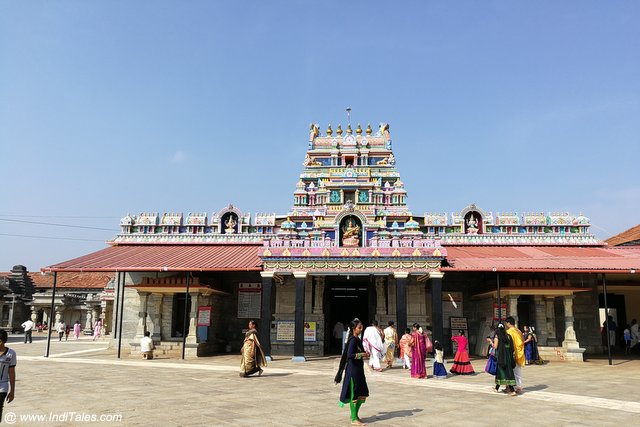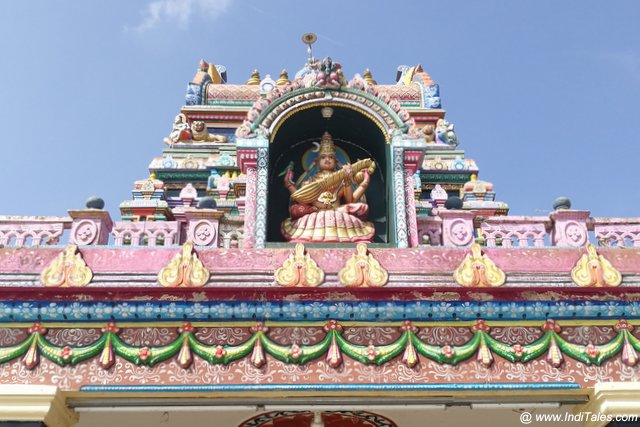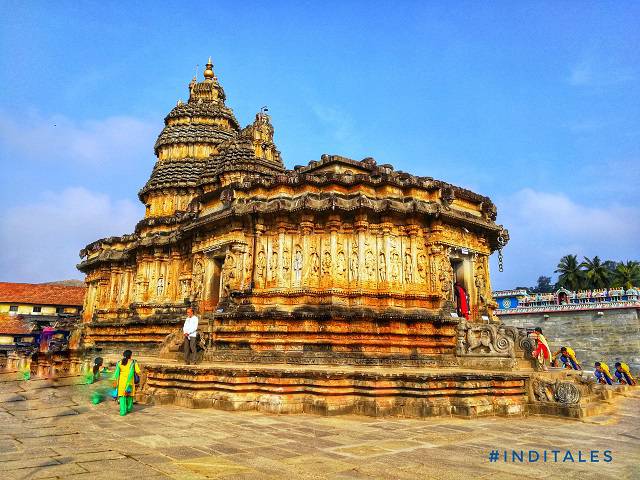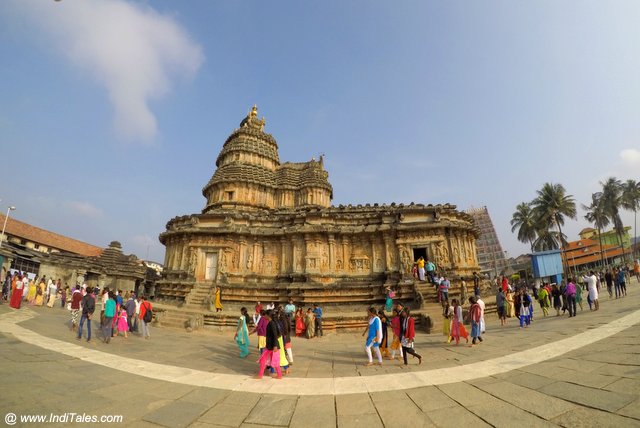SRINGERI – THE TEMPLE TOWN AROUND SHARADA PEETHAM
SRINGERI – THE TEMPLE TOWN AROUND SHARADA PEETHAM
Sringeri gets its name from Rishi Shringya, son of Rishi Vibhandaka. In fact, the full name is RishiShringra Giri, Giri meaning mountain. The etymology and the name tracing back to the days of the Rishis tells us that this place has been inhabited for a very long time.

Sringeri, as we see it today, owes its history, heritage, and lineage to Adi Shankaracharya. The town today revolves around the Shardamba Temple and Sharada Peetham set up by him in 8th CE, with Tunga River flowing between them.
Temples of Sringeri
The town has 40 or more temples. We visited some of them and here is what we saw:
Sharadamba Temple

We entered the Sharadamba Temple through its tall Raj Gopuram that is a very recent addition to the temple complex built in 2014. Being the tallest structure, it is visible from anywhere in and around the town. It defines the skyline of this small temple town and the temple complex.

Sharada Devi is the principal presiding deity of Sringeri. It is believed that Adi Shankara brought Sharada Devi here from Kashmir, where he spent some time. The original Sharada Peeth of Kashmir is now in Pak occupied territory.

Inside the temple, Sharada Devi is seated on a Chakra or a wheel and holds a mala in her hand. The original idol of Sharada Devi was made in Sandalwood. Why Not! Sandalwood is found in abundance in the region. The current image in gold was installed in 14th CE by the Saint Vidyaranya. Vidyaranya was the 12th Shankaracharya of Sringeri Mutt who also played a role in establishing the Vijayanagara empire. The idol is adorned with so many clothes, jewels, and flowers that it is not easy to make out the finer details. To add to this, the crowds at the temple do not allow you to stay in front of Sharadamba for more than a few moments.

Saraswati
Sharadamba represents the Goddess Saraswati here. As a writer, I always seek her blessings so that my words have the power to make an impact. Here, she is also believed to be an incarnation of Ubhaya Bharti, the wife Mandana Misra who famously debated with Adi Shankaracharya.
I was told that till about 100 years back the whole temple was built of wood and probably Sandalwood. It was lost in a fire and the current structure is built in a typical Dravidian style.
Every Friday, during Navratri and on some other special days, the Goddess goes out in a procession on a chariot. You can see a large silver and a golden chariot in the temple premises.
Parents bring their children here at Sharada Temple to begin their studies. You see many infants walking in with black slates and their parents.
Vidyashankara Temple

Archaeologically, Vidyashankara is the most beautiful temple in Sringeri. The moment we entered the Sharadamba Temple complex, it is Vidyashankara temple that caught our eye. The sculpted stone structure standing on a high platform in a unique semi-circular form is stunning, to say the least. We naturally gravitated towards this temple and stood in front of it admiring its unique shape.

We entered the temple and the first thing I did was counting the pillars inside the Mandapa. Yes, they were 12 in number though they were not all equal. The four pillars in the corners were larger than the rest. I had read about these 12 pillars representing 12 zodiac signs. As the sun moves from the zodiac to Zodiac, the first rays of the Sun fall on the pillar of the same zodiac. I could spot zodiac signs on some of the pillars but could not locate them on all the four pillars in the corners. The kind priest helped us find all of them despite huge crowds that he had to handle. You meet the Aries and Taurus Pillars as you enter the temple. Scorpio and Libra are closest to the deity.

The granite stone in a circular shape in the middle of the Mandapa has slanting lines etched on it. I believe these are to trace the trajectory of the Sun & may have been used while building the temple. If it has a current use, I could not gather. On the ceiling, there are lotuses and parrots.
Sanctum
We moved closer to the sanctum where there is a large Shivalinga in black stone. It is called Vidyashankara Linga. There are many accounts of people getting a divine vision when they meditated on this linga. I could not imagine meditation here as the place was full of people and the sounds they produce. On the left of Shivalinga is a Vidya Ganapati in black stone and on the right a Devi in the form of Durga. On the two Equinoxes day, the sunrise reaches the main deity – Vidyashankara Linga.
I was there towards the end of December when the sun is in Sagittarius. I saw a beautiful image in metal between the pillars of Sagittarius and Capricorn. About 12 inches tall, it was on a pedestal and covered with flowers and a priest was performing a Puja. He told me it is the image of Shanichar Dev – the presiding deity of Dhanu Rashi or Sagittarius.

History
Vidyashankara temple was built for Guru Visyashankara in 14th CE during the time Vijayanagara Empire of Hampi. However, it does have glimpses of the earlier Hoysala or Chalukyan architecture in it. Standing on a tall platform it is a rectangularly shaped temple with curved or apsidal sides at both ends. Outer walls of the temple are full of sculptures depicting the deities from all the 6 paths defined by Adi Shankara – Shiva, Vishnu, Shanmukh, Devi, Ganesha, and Surya. Corners of the temple have stone interlocked chains, a marker of Vijayanagara temple architecture. Remember I saw this also at 100 Pillar Hall at Varadaraja Perumal Temple in Kanchipuram.
Behind the Vidyashankara Temple in Sharadamba Temple complex are a series of small stone temples, small enough to house one deity at most. All of them were closed so I could not figure out who they are dedicated to and if they are ever opened and worshipped.
Biggest festivals of Vidyashankara temple are celebrated in Kartik Shukla Paksha i.e. the fortnight after Diwali.
Adi Shankara Temple & Sharadamba Temple Complex
A little behind the Sharadamba Temple is a small but beautiful temple dedicated to Adi Shankara. You can see his life story painted on the outside walls of the temple. Two stone elephants adorn the small staircase that leads to the temple sanctum.
Next to it is a big hall where you see the young children lined up for their first writing.
There is a huge Yagnashala with lovely wooden pillars and a stage next to it. I wonder how it would be to see a Yagna being performed here or a musical play being enacted here.
Just outside the complex, there is a bookstore where you can buy the literature on Advaita Vedanta and Adi Shankaracharya.
Malahanikareshwara Temple
This is an ancient temple located on a hill called Mallappa Betta. We took the road that goes to the temple gate, but if you are an enthusiast you can climb the steps leading to the temple. If you ask around, ask for the temple on Betta (hill), most local people do not know it by its full name.

At the heart of this ancient temple is a massive Shivalinga that is supposed to release all the Mala or toxins from your life. Other temples in the complex include a temple to Bhavani. You must see the Stambha Ganapathi or a small Ganesh shrine in the pillar. It is similar to the Anjaneya temple that I saw outside Ekambareshwara Temple in Kanchipuram. Near the entrance, there are Samadhis dedicated to saints.
Situated at height, this temple takes you at a higher platform in many ways. Surprisingly, this temple had no crowd. We were the only visitors when we visited.
4 Direction Temples setup by Adi Shankara
It was customary to mark the boundaries of sacred space by placing temples in all four directions of the Khsetra or the region. Adi Shankara had set up four small temples in 4 directions that are still small temples. All of them are located on small hillocks.

Kere Aanjaneya Temple in West – We stopped here on way to Durgamba Temple.
Kala Bhairav Temple in East – This is closest to the Sharada Peetham. Approach it via the suspension bridge and you would be treated with a great view of the temple complex next to Tunga River.
Durgamba Temple in South – This is the temple farthest from the city in the direction of Mangalore.
Kalikamba Temple in North – This temple was closed when I reached there around lunchtime, but it is a small temple located on the edge of a small hill within the city.
Sringeri Sharada Peetham or Mutt
The Sharada Peetham was established by Adi Shankaracharya, whom the popular historians and this Sharada Peeth date to 8th CE, making it a living tradition for 1200+ years. However, the other two Mutts established by Adi Shankara in Dwarka and Kanchipuram date him back to 6th BCE making it a 2500+-year-old tradition. The genealogy trees also trace the Shankaraycharyas in these Peethams accordingly. The current Shankaracharya of Sharada Peetham is 36th in line while the one at Kanchipuram is 70th in line.

Logic says, probably Sringeri Sharada Peetham was established at a later date. The irony comes from the fact that it is believed to be the First Peetham established by Adi Shankaracharya. Sureshwaracharya was the first pontiff of this Sharada Peetham, who is also identified as Mandana Misra, the one who debated with the Adi Shankara.
Legend says that Adi Shankaracharya was walking on the banks of River Tunga, he saw a Cobra protecting a frog in labor from the scorching heat with its hood. If natural enemies can protect each other, this must be a great place to establish the seat of learning. So, this is how Sharada Peetham, first of the four Peethams that Adi Shankaracharya would go on to establish, was set up.
Feeding the Fish
We walked towards the Sringeri Mutt through the bridge that connects the two banks of Tunga River. Bridge gives a lovely the aerial view of the ghats on Tunga river where pilgrims were feeding the fish. It is a fascinating scene to watch. The clear waters of Tunga River are punctuated by rocks. On the right-hand side, along with the western ghats, it is full of big black fishes while on the left it is clear. After all, everyone, including fishes always run to shores that serve food. The fishes are well fed and happy. The puffed rice sellers make a living by feeding these fishes via pilgrims.

We walked across the bridge to reach a little more forested part with many buildings, including the administrative building of the Sharada Mutt. Aham Brahmasmi – the Mahavakya or the sentence that was assigned to this Sharada Mutt by Adi Shankaracharya is written on the buildings here. Of the 4 Vedas, Sringeri Sharada Peetham has Yajur Veda. At one places we saw young scholars reciting the Vedas sitting in front of the image of their Guru.
Sharada Peetham has many buildings, mostly samadhis of the past Shankaracharyas. The Guru Nivas is a huge hall where Shankaracharya gives darshan to his devotees. We were lucky that he walked in almost as soon as we reached here. We bowed our head and came out to admire the rest of the city.
Elephants

As we were returning from the Sharada Mutt back on the bridge over Tunga River, we saw the temple elephants walking towards the bridge. It was fun to walk between the two elephants with their tinkling bells amusing pilgrims as they moved. They stood in the Sharadamba temple complex taking Bananas as offerings and giving blessings with their trunk.
Sharada Peetham has a library of Sanskrit Manuscripts, that I could not see during this visit. Hopefully next time.
Parshwanath Jain Basadi

The Parshwanath Jain Basadi also called Parshwanath Basadi is located in the main lane that leads to Sharadamba temple. Not more than 200 meters away from the Gopuram. Its blue door can be mistaken for a shop door like the many shops surrounding it. We entered through the door and saw the typical Jain temple just like the ones we saw at Moodbidri. There are platforms with pillars on both sides of the entrance gate.
The stone temple dates back to 1150 CE, making it the oldest living structure in the holy town. We walked through the pillared Mandapas, where a lot of excavated Jina Murtis were on display. The sanctum was closed. But, in a way, that you can see all the idols inside. The main idol in black stone is of 23rd Jain Tirthankar Parshavnath. What is interesting in this temple is the silver image of Padmavati in a palanquin.

Comments
Post a Comment